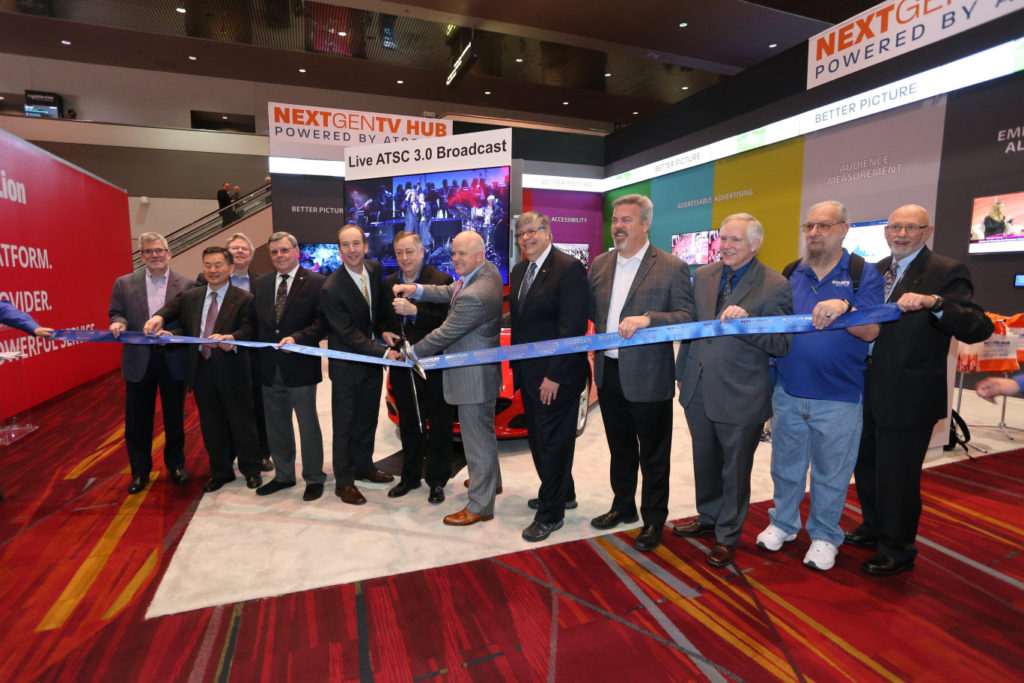
“The Road to ATSC 3.0: Powered by ATSC 3.0” Ribbon Cutting CeremonyDeployment of ATSC 3.0 is off and running, with a strong showing this month at this year’s NAB Conference in Las Vegas. More than 40 exhibitors and 22 technology-and-business sessions demonstrated the level of interest in the new Next Generation Broadcast TV standard, with a ribbon-cutting ceremony kicking off the activities.
ATSC President Mark Richer underscored the level of 3.0 presence at the show, saying “That’s how we know it’s real, and that’s how we know it’s happening,” and Sam Metheny, EVP/CTO at NAB, said that while ATSC is now “moving to the implementation phase,” it is a “living standard that will continue to evolve over time.” Mike Bergman, Senior Director, Technology & Standards at the Consumer Technology Association, anticipates “broad deployment, and a breathtakingly immersive viewing experience,” which should complement the growing momentum of 4K TV sales.
Now that the ATSC 3.0 standard has been approved, broadcasters can develop two-way, IP-based connections with their viewers and deliver TV experiences on par with other digital media. Looking to the future, conference panelists addressed key Next Gen TV capabilities, including enhanced audience insights, addressable advertising, interactivity, and personalization, along with plans to generate incremental revenue and audience engagement.
Broadcasters are used to slow change, but now need to change faster, even on a monthly basis. The world is changing faster, and consumer demands are changing, with OTA viewership growing, and OTT services and usage growing. Mobile viewing continues to increase, a cord cutting / shaving / nevers are changing TV marketplace dynamics. On-demand viewing is an assumed feature, and digital advertising is increasingly powerful, so targeted advertising is now essential.

SFNs (single-frequency networks, a broadcast technology comparable to mobile cellular networks) will enable all of these new services, and data analytics will drive the opportunities. The WiFi/mobile broadband return channel defined by ATSC 3.0 means that even simple receivers need a back channel.
While MVPDs (Multichannel video programming distributors, i.e. cable and satellite) have long provided a revenue stream to broadcasters through retransmission-consent agreements, this could be one key area of the change in business model made possible by ATSC 3.0, which is not mandated by the FCC, other than at the transmission layer, and whose carriage is not currently subject to retrans obligations.
Broadcasters are interested in gathering viewership data from mobile devices and doing dynamic ad insertion. Reaching individuals will be attractive to advertisers, and broadcasters can now put movies into home boxes for Netflix, bypassing MVPDs. ATSC 3.0 is thus poised as a medium to test new business models, and broadcasters can partner with other spectrum owners and mobile carriers to supplement the “traditional” mobile spectrum.

The Phoenix Model Market project is the first collaborative single-market effort to plan for and implement a transition to next-generation over-the-air television broadcasting. Twelve stations in the Phoenix market are participating, with service testing expected to start Q2’18, and consumer service testing in Q4’18. In addition to business model testing, consumer testing will extend into 2019.
Among the consumer-facing business models to be tested are program guide & hybrid TV, personalization, and emergency alerts. On the broadcaster side, content protection, data & measurement, advanced advertising, and transition models will be evaluated.
— agc